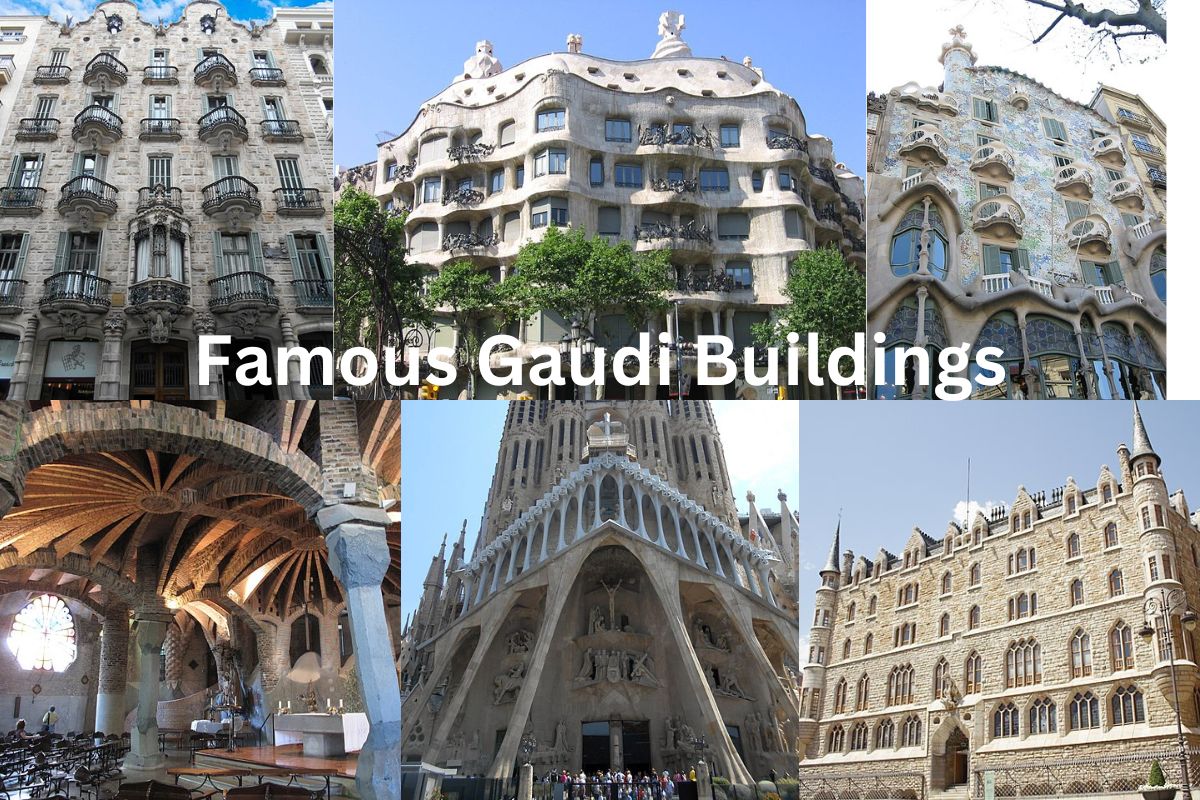Antoni Gaudí I Cornet was a well-known Catalan architect who was active in the late 19th and early 20th century. He was instrumental in the development of modernist architecture during this time period.
He was famous for his original approach to design, which was distinguished by its incorporation of natural materials and a one-of-a-kind sense of inventiveness.
Many of the structures that Gaudí designed may be identified by the curved forms, vibrant mosaics, and complex ornamentation that they include. These buildings are often recognized as being among the most unique and stunning buildings in the world.
Among of his most famous works include:
- The Sagrada Familia
- Park Güell
- Casa Batlló
- House Milà (La Pedrera)
- Palau Güell
- Casa Vicens
- Colònia Güell.
Gaudi’s buildings continue to be a tribute to his singular vision and aesthetic genius, and they continue to entice millions of tourists from all over the world each year.
Famous Gaudi Buildings
1. La Sagrada Familia
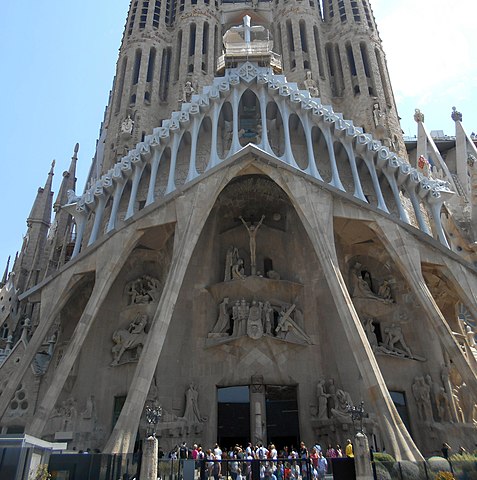
The Sagrada Familia is a huge basilica in Barcelona, Spain’s Eixample area. Antoni Gaudí designed it, and it has been under construction since 1882. The basilica is undoubtedly Gaudi’s most well-known work, with its towering spires, rich ornamentation, and distinct architectural style.
Gaudi worked on the Sagrada Familia for more than 40 years until his death in 1926, and the project has been carried on by a succession of architects and builders since then. Despite being under construction for well over a century, the basilica is still unfinished, with an estimated 70% completion.
The Sagrada Familia is known for its distinctive blend of Gothic and Art Nouveau styles, as well as its magnificent front and eye-catching interior. The Nativity Façade, the Passion Façade, and the Glory Façade are three great facades dedicated to distinct aspects of Christ’s life.
The basilica’s interior is distinguished by its towering columns, beautiful stained glass windows, and exquisite sculptural elements.
The Sagrada Familia is one of Barcelona’s most popular tourist attractions, attracting millions of tourists each year. Despite its incomplete state, it stands as a monument of Gaudi’s singular vision and artistic genius, as well as a testament to the enduring force of great architecture.
2. Casa Batlló
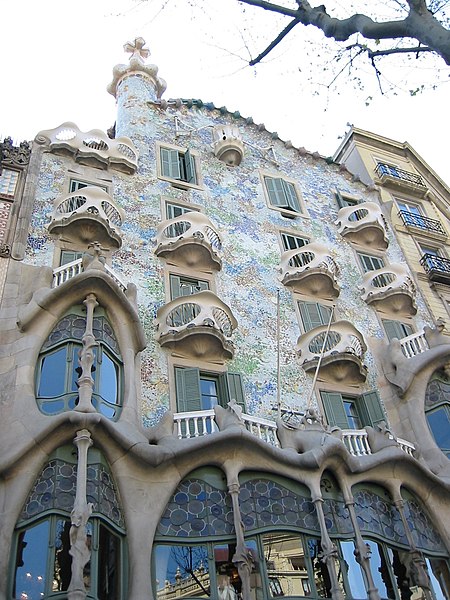
House Batlló is a modernist structure in the center of Barcelona, Spain. Antoni Gaudí designed it and it was built between 1904 and 1906. The structure is one of Gaudí’s most well-known buildings, notable for its unusual exterior and inventive design.
The wealthy industrialist Josep Batlló commissioned Gaudí to develop a one-of-a-kind and eye-catching house. Gaudí was inspired by the organic forms of nature and integrated a variety of materials and design aspects that were cutting-edge at the time.
House Batlló’s exterior is distinguished by its undulating curves and brilliant hues. The roof is shaped like a dragon’s back, with enormous scales made of colorful ceramic pieces. The balconies resemble masks, and the entire structure appears to be living and moving.
Casa Batlló’s interior is as inventive as its appearance. The structure has an unusual center courtyard that allows natural light to flood the interior. Mosaics composed of various materials, including broken glass and ceramic tiles, adorn the walls.
House Batlló is now a renowned tourist destination and a UNESCO World Heritage Site. It is considered one of Gaudí’s most important works, and it exemplifies his distinct vision and artistic genius.
3. Casa Milà
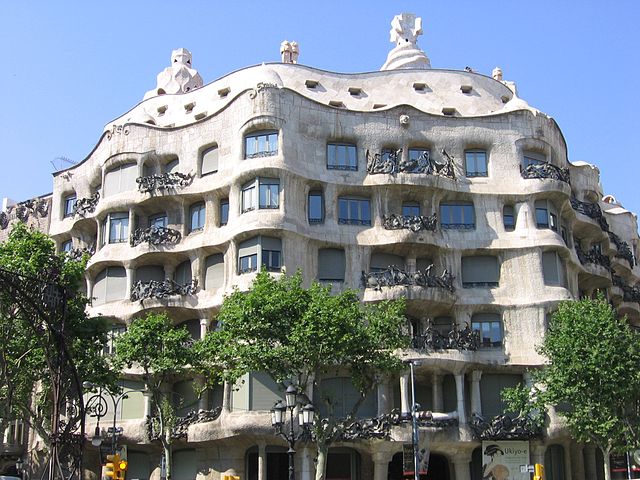
Casa Milà, commonly known as La Pedrera, is a modernist building in Barcelona’s Eixample area. It was designed by Antoni Gaudí and erected for the wealthy Milà family between 1906 and 1910.
Casa Milà is distinguished by an undulating front that looks to be constructed of living rock. The facade is made up of a sequence of big, unevenly shaped stone blocks that are meant to evoke sea waves.
The rooftop is equally striking, with a succession of practical and beautiful sculptural elements.
Casa Milà’s interior is just as magnificent as its appearance. The structure includes a central courtyard that allows natural light to flood the interior, as well as a succession of organic forms inspired by nature. The structure was intended to be an useful living area, but it is also a work of art in and of itself.
Casa Milà is now a renowned tourist destination and a UNESCO World Heritage Site. It is considered one of Gaudí’s most important works, and it exemplifies his distinct vision and artistic genius.
4. Casa Vicens
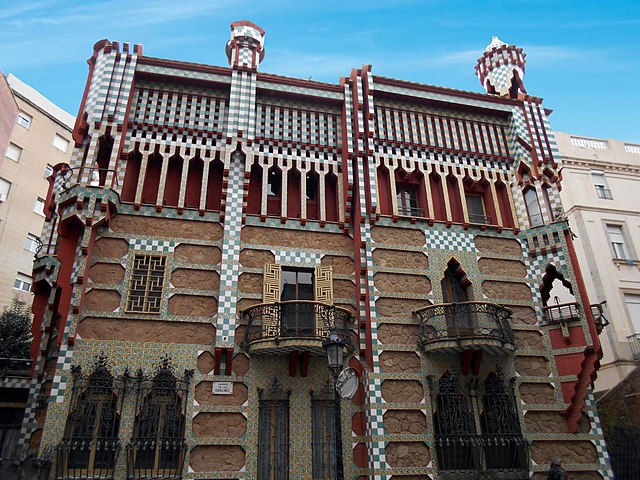
House Vicens is a modernist building in Barcelona’s Gracia neighborhood. Antoni Gaudí designed it and erected it between 1883 and 1885 for rich businessman Manuel Vicens I Montaner.
Casa Vicens is noteworthy for its unique tile work and vibrant exterior. The structure was designed in a variety of architectural styles, including Islamic and Gothic Revival, and is distinguished by its exquisite ornamentation and use of natural materials.
Casa Vicens’ interior is as remarkable, with a succession of rooms built to reflect the natural beauty of the surrounding countryside. The structure includes a central courtyard that allows natural light to enter the interior, as well as a number of unique design elements inspired by nature.
Casa Vicens is now a renowned tourist destination and a UNESCO World Heritage Site. It is considered one of Gaudí’s most important works, and it exemplifies his distinct vision and artistic genius.
The structure was recently renovated and made accessible to the public, allowing visitors to appreciate the beauty and originality of Gaudí’s early work.
5. Palau Güell
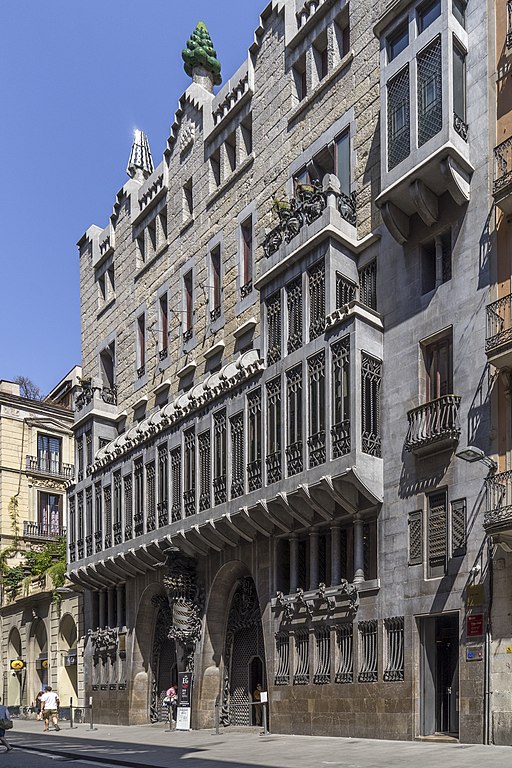
Palau Güell is a mansion in Barcelona, Spain’s El Raval area. It was designed by Antoni Gaudí and erected for the rich manufacturer Eusebi Güell between 1886 and 1890.
Palau Güell is known for its intricate decorations and eye-catching rooftop. The structure incorporates several architectural styles, including Gothic Revival and Art Nouveau, and is distinguished by its complex decoration and use of natural materials.
The interior of Palau Güell is equally spectacular, with a succession of chambers meant to mirror the era’s opulence. The structure includes a central hall covered in elaborate tiles and a number of unique design elements inspired by nature.
One of Palau Güell’s most distinguishing features is its rooftop. It is adorned with a slew of multicolored chimneys and ventilation towers modeled after medieval soldiers. The rooftop provides breathtaking views of the city and is a monument to Gaudí’s distinct vision and artistic ability.
Palau Güell is now a major tourist destination and a UNESCO World Heritage Site. It is recognized as one of Gaudí’s most notable works and exemplifies his distinct approach to design and building.
6. Gaudí House Museum
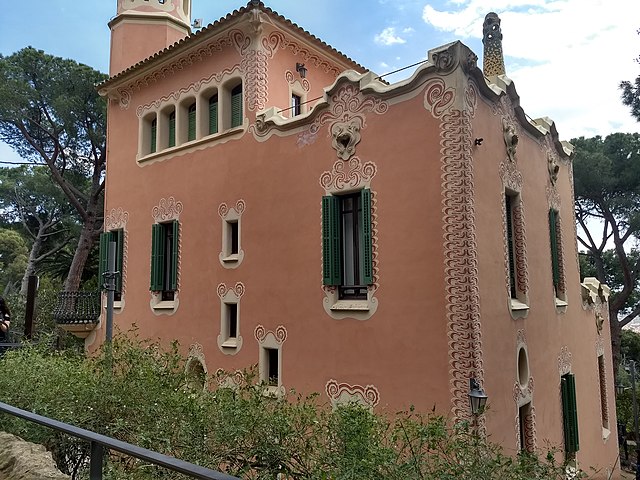
The Gaud House Museum, also known as the Casa-Museu Gaud, is a museum in Barcelona, Spain, located in Park Güell. The museum is housed in Antoni Gaudí’s former home, which he lived in from 1906 until his death in 1926.
The Gaudí House Museum has a collection of Gaudí’s furniture, drawings, and personal possessions, as well as a series of displays that explore his life and work. Visitors may observe the personal style and design ethos that influenced Gaudí’s creative approach to architecture and design firsthand.
The museum lies in the midst of Park Güell, which Gaudí also planned. The park has a variety of unusual design elements, such as bright mosaics and sculptural forms, and provides breathtaking views over the city.
Nowadays, the Gaudí House Museum attracts tourists and architecture aficionados who come to learn about the life and work of one of Spain’s most famous architects. The museum honors Gaudí ‘s singular vision and artistic genius, as well as the enduring force of great design.
7. Casa Calvet
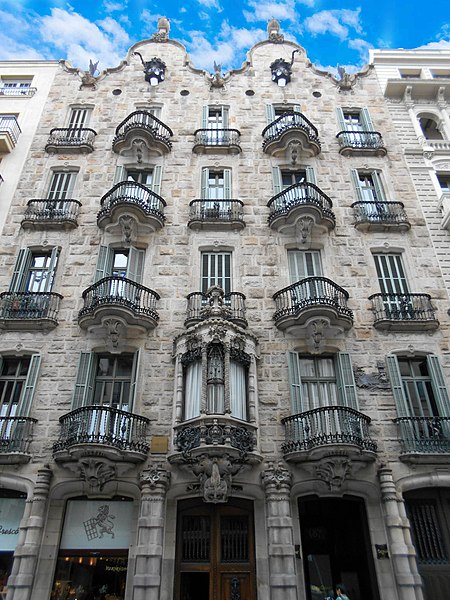
Casa Calvet is a modernist structure in Barcelona’s Eixample neighborhood. Antoni Gaudí designed it and erected it between 1898 and 1900 for textile producer Pere Màrtir Calvet.
Casa Calvet is distinguished by its restrained design, which contrasts with many of Gaudí’s other more flamboyant works. The structure has a straightforward rectangular shape and a plain stone facade. The decoration is kept to a minimum, with wrought iron balconies and modest sculptural features.
Casa Calvet’s interior is as understated as its façade, with a sequence of rooms that are intended to be utilitarian rather than decorative. The structure was intended to be a business space, with offices and a restaurant on the ground floor, rather than a residential dwelling.
Villa Calvet is now a renowned tourist destination and a reminder of Gaudí’s architectural diversity. While it is not as extravagant or big as some of his other works, it demonstrates his ability to create buildings that are both attractive and efficient. The building presently houses a law practice and serves as a reminder of one of Spain’s most famous architects’ enduring legacies.
8. Church of Colonia Guell
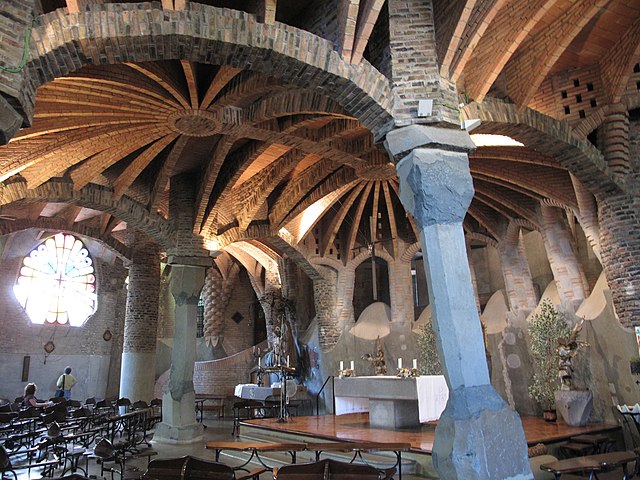
The Church of Colnia Güell is a Catholic church in Colnia Güell, an industrial area just outside Barcelona, Spain. It was designed by Antoni Gaudí between 1898 and 1914 and was meant to act as the village’s spiritual focus.
The Church of Colnia Güell is distinguished by its distinctive design, which integrates a number of novel architectural aspects. The interior of the church is designed to look like a forest, with a series of leaning columns supporting the ceiling and creating an organic movement.
The columns are composed of an unusual combination of materials, including brick, stone, and iron, and are plastered to give a smooth, organic appearance.
The church is particularly remarkable for its creative material use, such as the utilization of parabolic arches and vaults, which enable more light to penetrate the area. The walls are decorated in beautiful mosaics, and the ceiling is painted in a vibrant shade of blue, giving visitors a sense of awe and wonder.
While being unfinished, the Church of Colnia Güell is considered one of Gaudí’s most important works and a tribute to his singular vision and aesthetic ability. The structure is now a UNESCO World Heritage Site, and visitors can experience the beauty and inventiveness of Gaudí’s work firsthand.
9. Colegio de las Teresianas
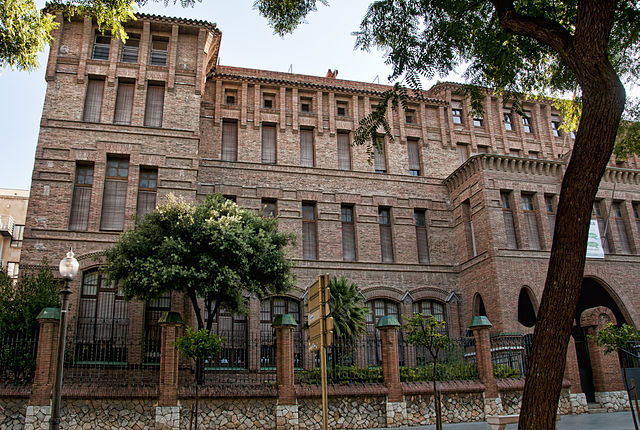
The Colegio de las Teresianas, often known as the Teresian School, is a school in Barcelona’s Sarrià-Sant Gervasi area. It was designed by Antoni Gaudí and built for the Society of Saint Teresa of Jesus, a Catholic religious order, between 1888 and 1890.
The Colegio de las Teresianas is noteworthy for its distinctive design, which combines Gothic and Art Nouveau architectural elements. The structure incorporates a number of organic forms and curving lines that are typical of Gaudí’s work.
The building’s facade is covered in a succession of multicolored tiles and sculptural pieces, and the interior is filled with elaborate details and unique design elements.
The chapel on the top level of the Colegio de las Teresianas is one of the most prominent aspects of the building. The chapel is distinguished by its organic forms and curving lines, as well as a number of unusual design elements, such as a pulpit suspended from the ceiling.
The Colegio de las Teresianas is still in use as a school and is open to the public for tours. It is considered one of Gaudí’s most important works, and it exemplifies his distinct vision and artistic genius.
10. Casa Botines
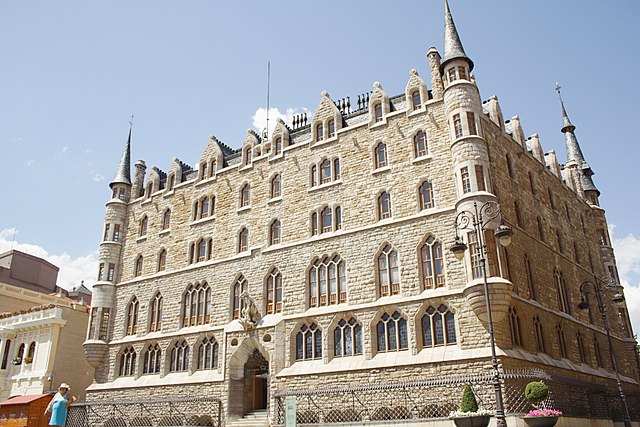
House Botines is a modernist structure in the Spanish city of León. It was designed by Antoni Gaudí and erected between 1891 and 1892 for Joaqun Botines, a local textile company.
Casa Botines stands out for its Gothic-inspired style, which contrasts with the majority of Gaudí’s other works. The structure is square in shape, with a stone exterior that includes intricate sculptural embellishments and wrought iron balconies.
Casa Botines’ interior is almost as magnificent as its appearance, with a succession of rooms meant to depict the grandeur of the era. The structure includes a central courtyard covered in a succession of colorful tiles, as well as a number of unique design elements inspired by nature.
Villa Botines is now a renowned tourist destination and a reminder of Gaudí’s architectural diversity. While it is not as well-known as some of his other works, it demonstrates his ability to design both attractive and useful buildings. The structure today houses a bank and serves as a reminder of one of Spain’s most famous architects’ enduring legacies.

